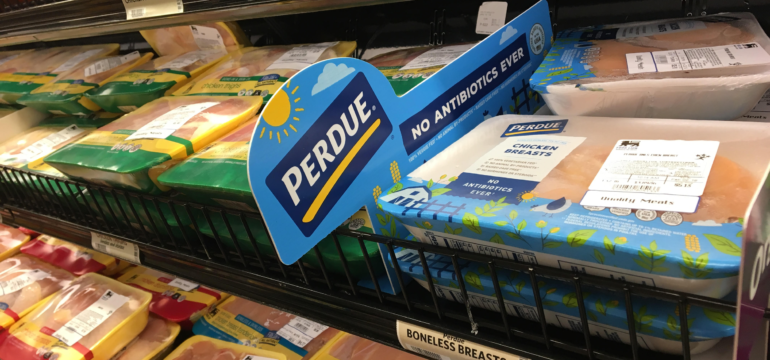![]()

Consumer brands Perdue and Tyson have made commitments to “no antibiotics ever” in their products. Photo by Lauren Sipple
When you walk down the meat aisle at your grocery store, you’re likely to see the words “No Antibiotics Ever!” prominently displayed on a variety of products. Consumer brands such as Tyson® and Perdue® have committed to producing meat in this manner; restaurants including Chick-fil-A, McDonalds, Chipotle, and Panera Bread have all taken steps to source meat that reduces antibiotic use. If you commonly purchase such products, you’re not alone. A Consumer Reports survey found that 43% of consumers often or always buy meat products that are raised without antibiotics (Calvo & Meltzer-Warren, 2018).
Antibiotics are used in food animals to help promote animal health by treating diseases caused by bacterial infection, either by killing the bacteria or making it difficult for them to grow and multiply. Such antibiotics are known as medically important antimicrobial drugs. However, in the past, antimicrobial drugs could have also been used for production purposes – that is, improving weight gain or feed efficiency of entire herds or flocks of food animals. Recent guidance issued by the FDA has deemed that such practices are no longer considered acceptable (FDA, 2013). Antimicrobial drugs used in animals must only be sold for the purpose of ensuring animal health.
Why did the FDA draw the line on antibiotic use and cause the food industry to shift away from this method of production efficiency? The use of antibiotics in food animals poses a serious risk to human health in the form of antibiotic resistance. When an antibiotic is administered to a food animal, most of the bacteria are killed. However, some bacteria may be resistant to the antibiotic. These bacteria can intrinsically neutralize the antibiotic, remove the antibiotic, or even prevent it from attaching completely. These bacteria can continue to grow and multiply, even when an animal is treated with an antibiotic, and through this process, strains of antibiotic-resistant bacteria can evolve (CDC, 2018). Though not all food-related, the Center for Disease Control (CDC) estimates that over 2 million illnesses and 23,000 deaths are caused by antibiotic-resistant microorganisms annually, which demonstrates the severity of this epidemic (CDC, 2013).
The CDC specifies several drug-resistant bacteria which can be spread to humans through consumption of contaminated animal products such as meat. These are considered a serious threat to public health and include Campylobacter, both non-typhoidal Salmonella and Salmonella Typhi, and Shigella (CDC, 2013). Illness caused by one one of these pathogens is much more difficult to treat as the antibiotics used to treat these diseases in humans are not effective against these drug-resistant bacteria.

Bulk loads of milk are tested for beta-lactams, an antibiotic residue, prior to being accepted at any dairy processing facility. Any product that tests positive for these residues cannot be sold and must be discarded (FDA, 2017). Photo from Pixabay.
Antibiotic resistance may also be genetically transferred to human intestinal microflora from the resistant bacteria (Landers et al, 2012). Hypersensitivity of humans to antibiotics is also a concern. Studies by the FDA have concluded that antibiotic residues can in some cases remain in animal products for periods of time following administration of the antibiotic (21 CFR § 510.110(c)). Though it is somewhat unlikely due to the low concentration at which antibiotic residues are present in food, an individual who has been sensitized to a particular antibiotic may experience symptoms such as dermatitis, serum sickness, gastrointestinal symptoms, vasculitis, asthma, and others if they come into contact with one of these residues, depending on the reaction type and severity of hypersensitivity (Dayan, 1993).
Due to these concerns, new antibiotic drugs must be approved by the FDA as safe and effective for use in the animal, and must also be safe with regard to human health prior to being administered to food animals (21 CFR § 514.1). In order to assure that antibiotics are used appropriately, the use of over-the-counter product was discontinued in January 2017 as a result of the implementation of Guidance for Industry (GFI) #213, and all antimicrobials of medical importance for animal use were transitioned to prescription or Veterinary Feed Directive status. This means that the administration of antimicrobial drugs must be overseen by a clinically trained and licensed veterinarian (FDA, 2013). The implementation of GFI resulted in a decrease of 33% in sales and distribution of these antimicrobials (FDA, 2018).

Approximately 42% of medically antimicrobial drug sales and distribution associated with food-producing animals were for cattle (FDA, 2018). Photo by Kat Jayne from Pexels
Protecting public health while still ensuring the health and well-being of animals makes the issue of antibiotic use in food animals complex. There is still some uncertainty about the risks of resistance associated with treating food animals with antibiotics, and therefore further research is needed (Landers, 2012). Regardless, the judicious use of medically important antimicrobials is now an important, highly regulated practice in ensuring a healthy population of food-producing animals whose products are safe for consumption long-term.
References
Antibiotics used in food-producing animals, 21 CFR § 510.110.
Calvo, T., & Meltzer-Warren, R. (2018, November 30). What ‘no antibiotics’ claims really mean. Retrieved from https://www.consumerreports.org/overuse-of-antibiotics/what-no-antibiotic-claims-really-mean/
CDC. (2013). Antibiotic resistance threats in the United States. Retrieved from https://www.cdc.gov/drugresistance/threat-report-2013/pdf/ar-threats-2013-508.pdf
CDC. (2018a, May 29). Appropriate antibiotic use: community. Retrieved from https://www.cdc.gov/antibiotic-use/community/about/antibiotic-resistance-faqs.html
Dayan, A. (1993). Allergy to antimicrobial residues in food: assessment of the risk to man. Veterinary Microbiology, 35(3-4), 213-226. doi:10.1016/0378-1135(93)90146-x
FDA. (2012). Guidance for industry: The judicious use of medically important antimicrobial drugs in food-producing animals (#209). Retrieved from https://www.fda.gov/downloads/AnimalVeterinary/GuidanceComplianceEnforcement/GuidanceforIndustry/UCM216936.pdf
FDA. (2013). Guidance for industry: New animal drugs and new animal drug combination products administered in or on medicated feed or drinking water of food producing animals (#213). Retrieved from https://www.fda.gov/downloads/AnimalVeterinary/GuidanceComplianceEnforcement/GuidanceforIndustry/UCM299624.pdf
FDA. (2017). Grade “A” Pasteurized Milk Ordinance. Retrieved from Public Health Service/Food and Drug Administration website: http://ncims.org/wp-content/uploads/2018/06/2017-PMO-FINAL.pdf
FDA. (2018). Summary report on antimicrobials sold or distributed for use in food-producing animals. Retrieved from FDA Center for Veterinary Medicine website: https://www.fda.gov/downloads/ForIndustry/UserFees/AnimalDrugUserFeeActADUFA/UCM628538.pdf
Landers, T. F., Cohen, B., Wittum, T. E., & Larson, E. L. (2012). A review of antibiotic use in food animals: Perspective, policy, and potential. Public Health Reports, 127(1), 4-22. doi:10.1177/003335491212700103
New animal drug applications, 21 CFR § 514.1. (2018).






Leave a Reply